We’re back with another week of the PLV report. This series will use the PLV metrics to contextualize player performance, and this week we’ll use our PLV model (Nick’s primer on PLV from last year can be found here) to validate some early-season pitching performances. PLV allows us to dig into individual pitches as needed, or to analyze how a pitcher’s repertoire works holistically. When showing Pitch Type cards, there will also be a plvLocation+ score shown, which is modeled similarly to PLV, but only uses the end locations of the pitch (horizontal, vertical, and location within the specific hitter’s strike zone) as inputs. With that information, we also can make Hitter PLV metrics which adjust a hitter’s decisions and performance based on the quality of the pitches they’ve faced.
Jumping off of Ryan’s post from last week, we’ll look at a few more players who have caught my eye, either with a strong first-half performance for pitchers or from an encouraging stretch before the All-Star break for hitters. I’ll run through one of each, per division.
Note: PLV metrics listed are current through Monday, July 15th.
AL East
We start off with a fun one: Kutter Crawford. Nick ranked him #45 in his last preseason Top 100, based on concerns that he’s something of a kitchen sink-type pitcher that doesn’t have a legit “go to” pitch. He was right that Kutter doesn’t have a single great pitch, but that’s because he has three that are very useful: the four-seamer, the Kutter, and the sweeper (the less said about his splitter, the better).
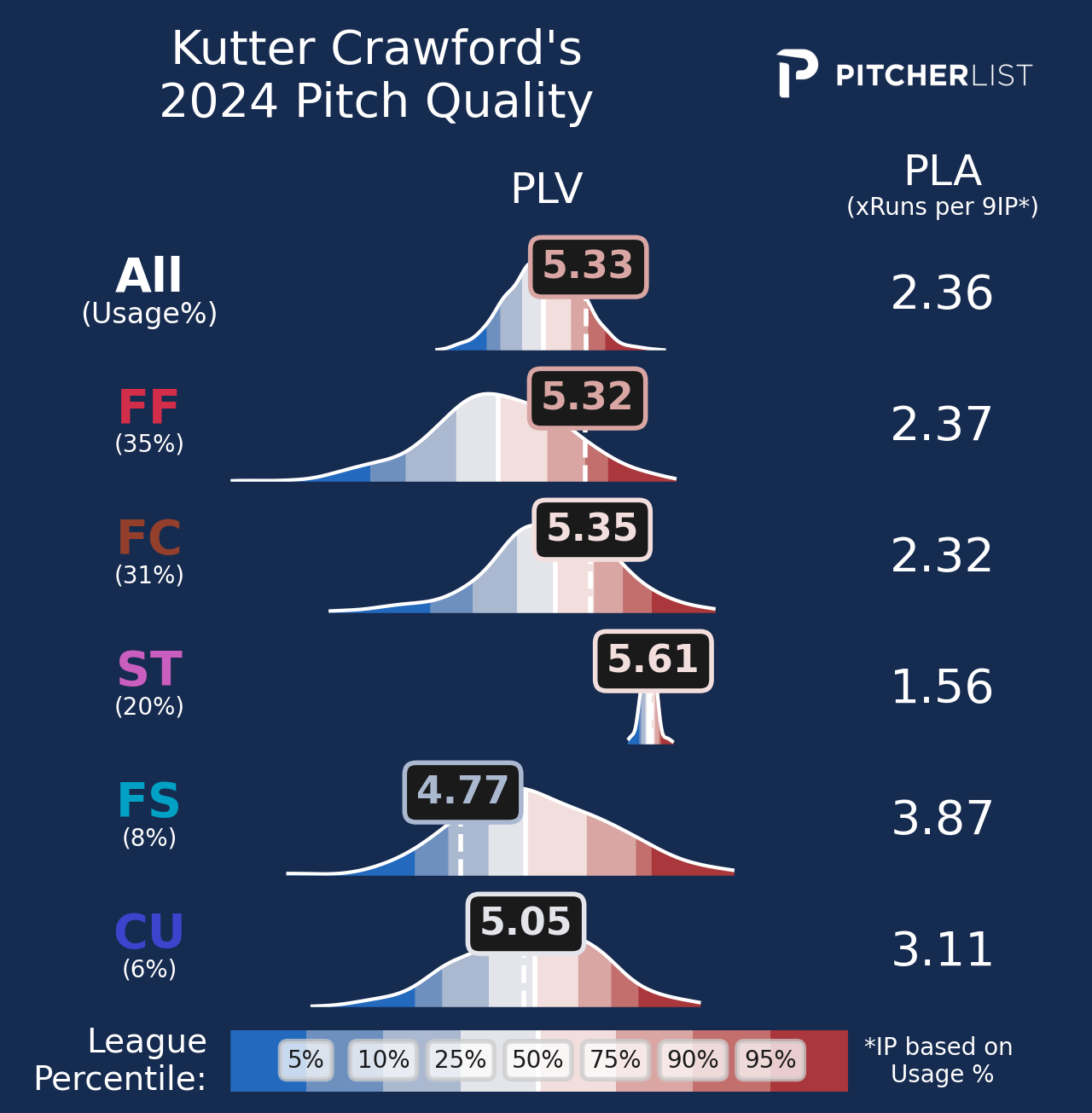
The four-seamer leads the way, and it should, given its ability to simultaneously earn strikes (31.2% CSW; 86th percentile) and limit hard contact (.373 xwoBACON; 60th percentile). That’s not his best pitch, though. That would be his eponymous Kutter. He uses it often enough that you could consider it his primary pitch some days, or a secondary off of the four-seamer on others. The pitch is below average by a handful of stuff components (notably velo and extension), but is saved by good locations and very good horizontal break (5.5″ of glove-side break; 88th percentile).
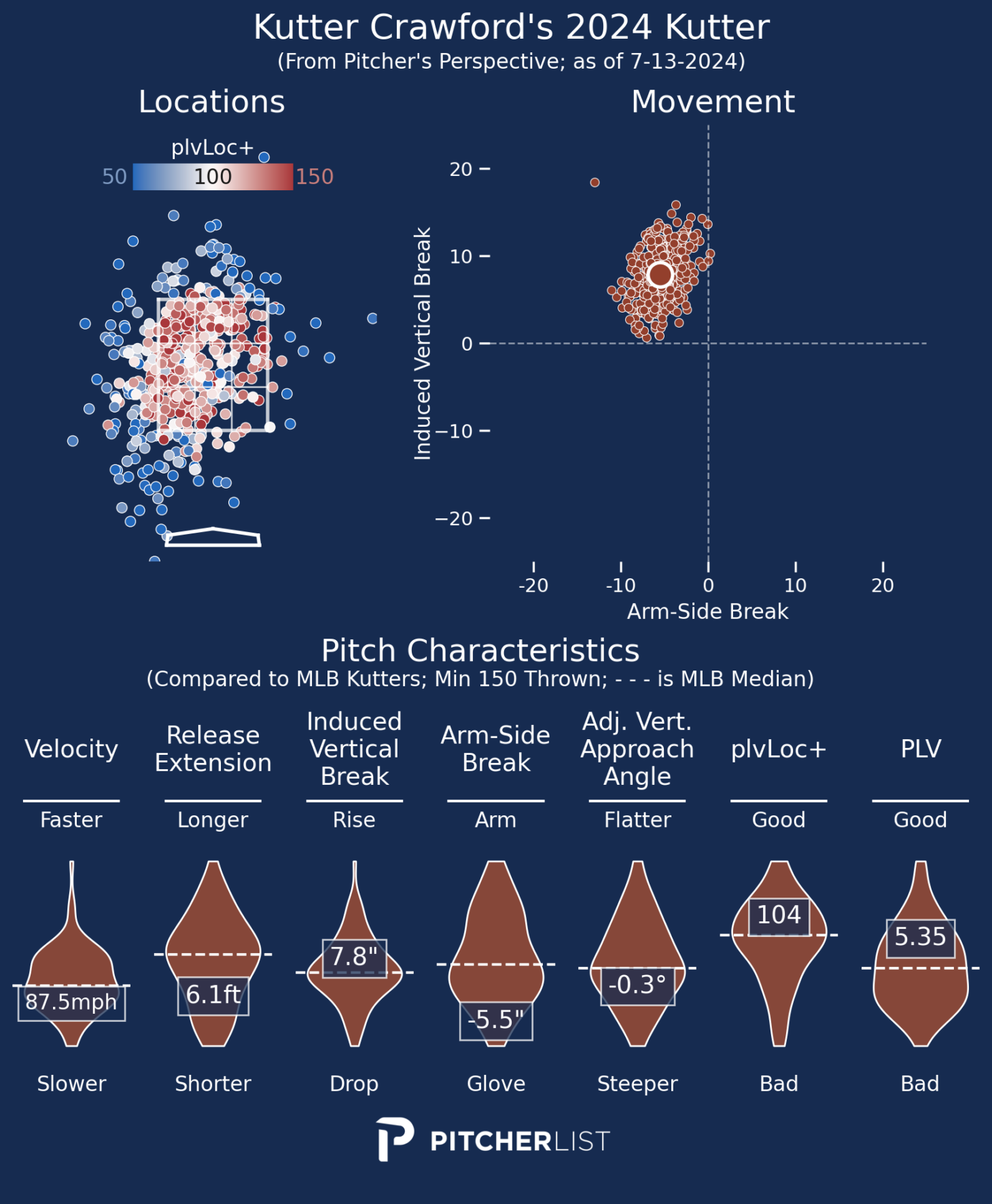
Three very good-to-great pitches will go a long way for a pitcher, especially one who pumps strikes as often as Crawford does (69.2%; 95th percentile). He’s taken some legit steps this year, and his tremendous first-half results are fully deserved.
The start to the season was rough for Randy Arozarena and any teams he found himself on since he was ice cold with a wRC+ of 37 in March/April. He showed some signs of life in May, with a 103 wRC+. He’s finally started to really hit his stride now that we’re through June and into July. The most obvious improvement is that he’s clawed his way out of the basement for Contact Ability. He made progress through June, and is now really finding his stride in July. This is the Arozarena everyone was expecting: low-to-mid 20s% strikeout rate, with an AVG north of .240.

The most exciting thing is that he’s managed this increase in the amount of contact he’s making without sacrificing his batted ball quality. That’s been consistently above average all season and is now starting to enter into elite territory. It may not be 2020’s Playoff Randy, but I will happily take Summer Randy the rest of the season.
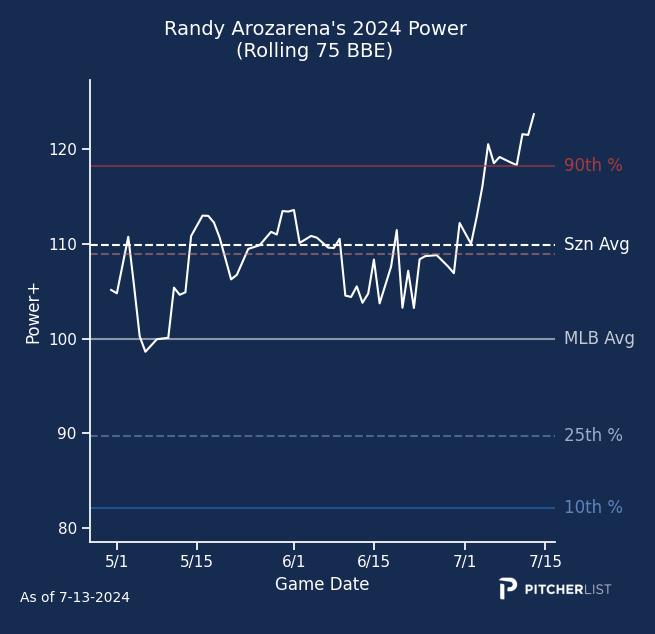
AL Central
Another Tier 8 pitcher from Nick’s preseason list makes an appearance here, with Flaherty starting the season off at #44. Flaherty and Kutter Crawford were trending in different directions, as Nick dinged Kutter a bit and noted that Flaherty possibly should have been in a higher tier. That feeling turned out to be spot-on, as he’s seemed to regain some of his early career mojo, and is crushing it this season. The similarities continue, as Flaherty also has a trio of very good pitches in his four-seamer, slider, and curveball. The difference is that he’s axed the rest of his repertoire because it just isn’t good.
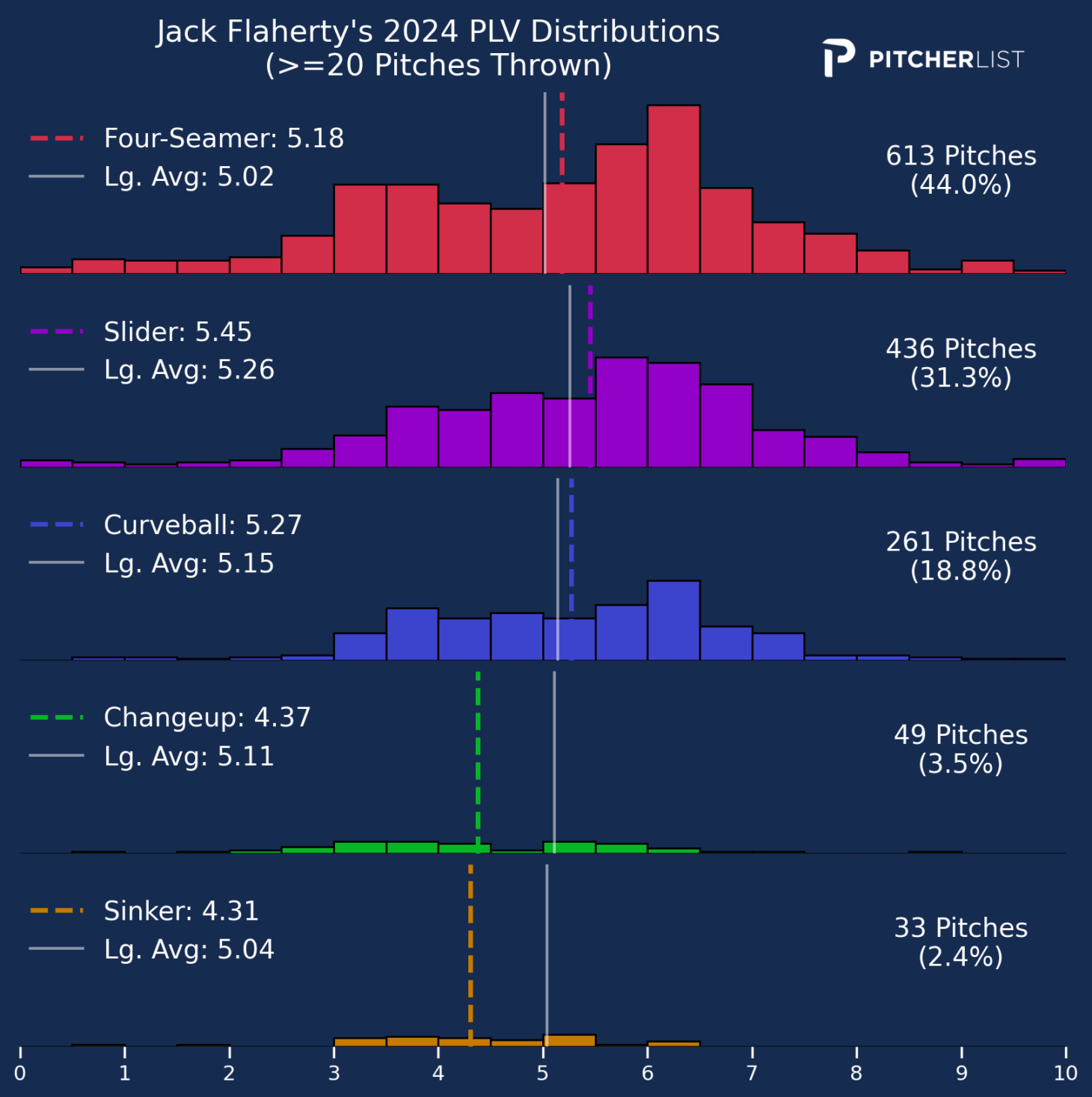
I love that Flaherty operates in three distinct velo bands: the four-seamer sits ~94mph, the slider is nearly 9mph lower, and the curveball is over 7mph lower than that). That prevents hitters from sitting on any one particular velocity range, and you can see the fits this is giving them from his 33.3% whiff rate (99th percentile!!)

That high-level whiffability allows Flaherty’s low zone rate approach to work (40% zone rate but a 65.7% strike rate; 4th percentile and 68th percentile, respectively). It’s easy to say “Hitters can just stop swinging”, but that’s easier said than done when you have three pitches who have such complementary movement and velo profiles. And hey, that low-zone, high-whiff approach worked pretty well for Blake Snell last year!
This is arguably my favorite combination of rolling charts I’ve seen this year. Buxton’s progressively bumped up his Contact Ability, from terrible to bad to above-average.
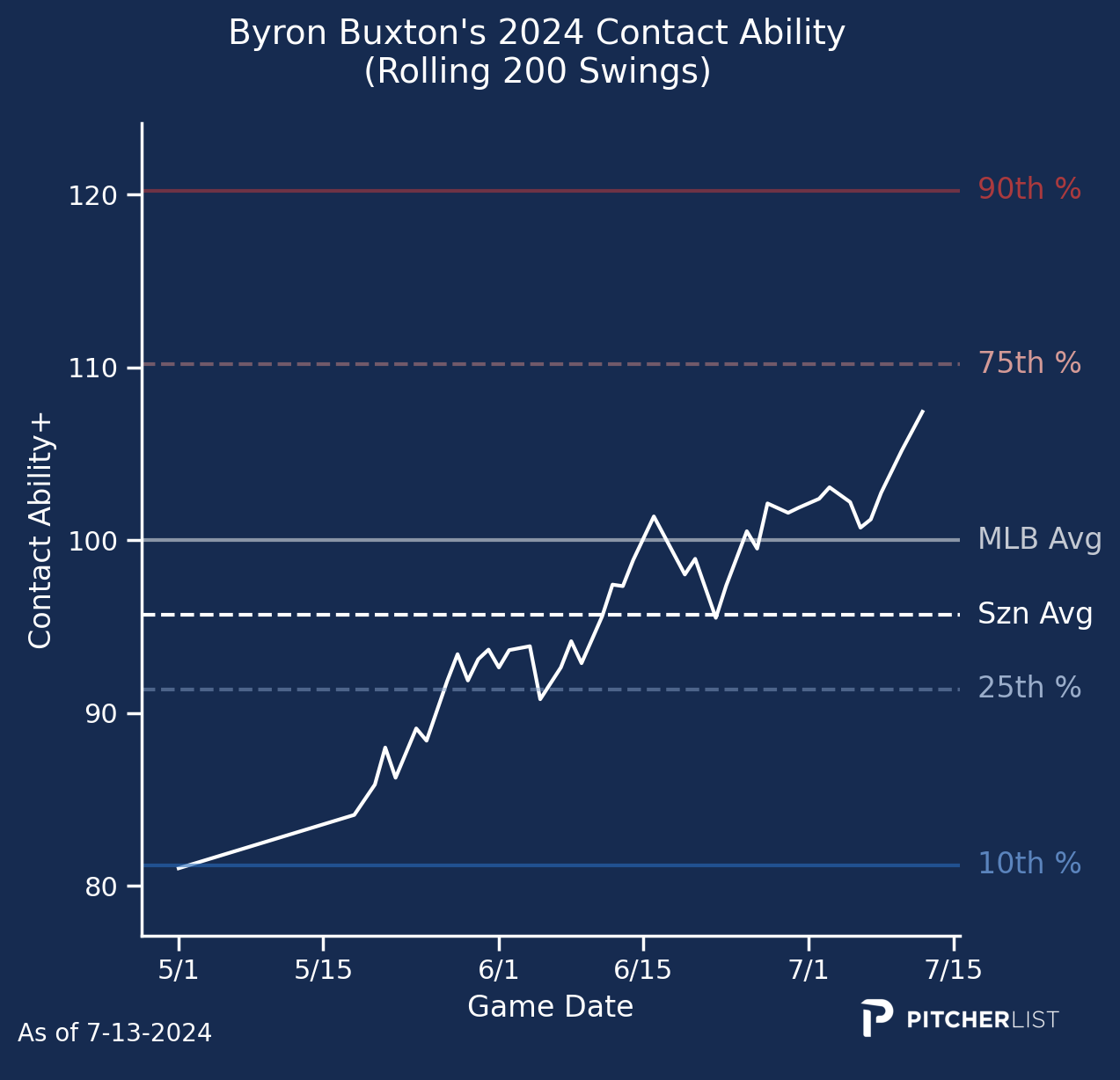
And now the follow-up: Buxton is absolutely mashing when he makes contact. He’s completely left the 90th percentile hitter behind and is in the rarefied air of the Judges and Ohtanis of the league.
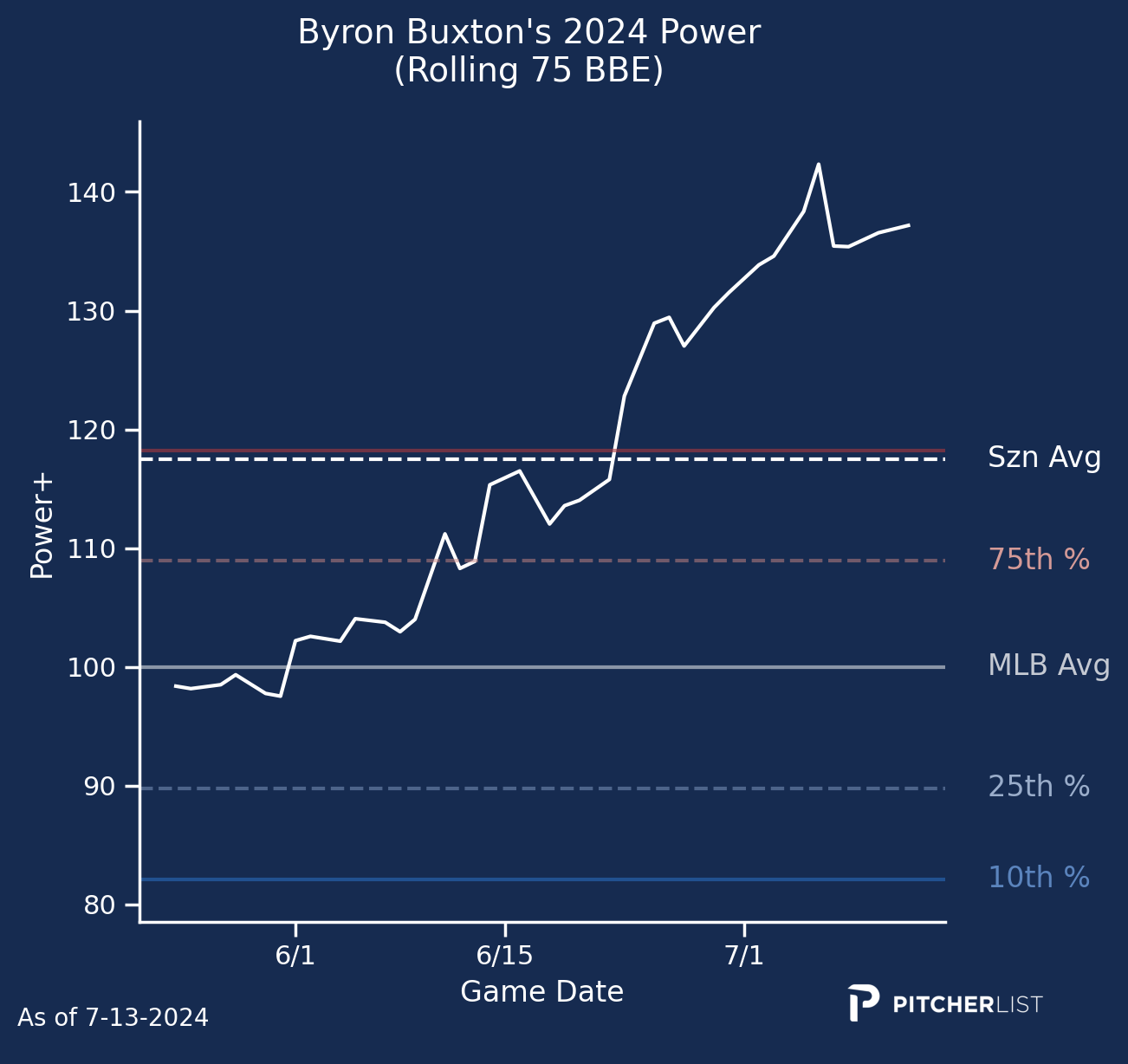
Similar to Arozarena above, Buxton has been making more contact and making more hard contact, which is a great combination for success in the second half.
AL West
Eovaldi has a bit of everything: mid-90s fastball, Nick-approved cutter, big curveball, slider that can bridge the cutter and curve, and the star of the show, the splitter. Eovaldi covers multiple velo and movement profiles with his repertoire.
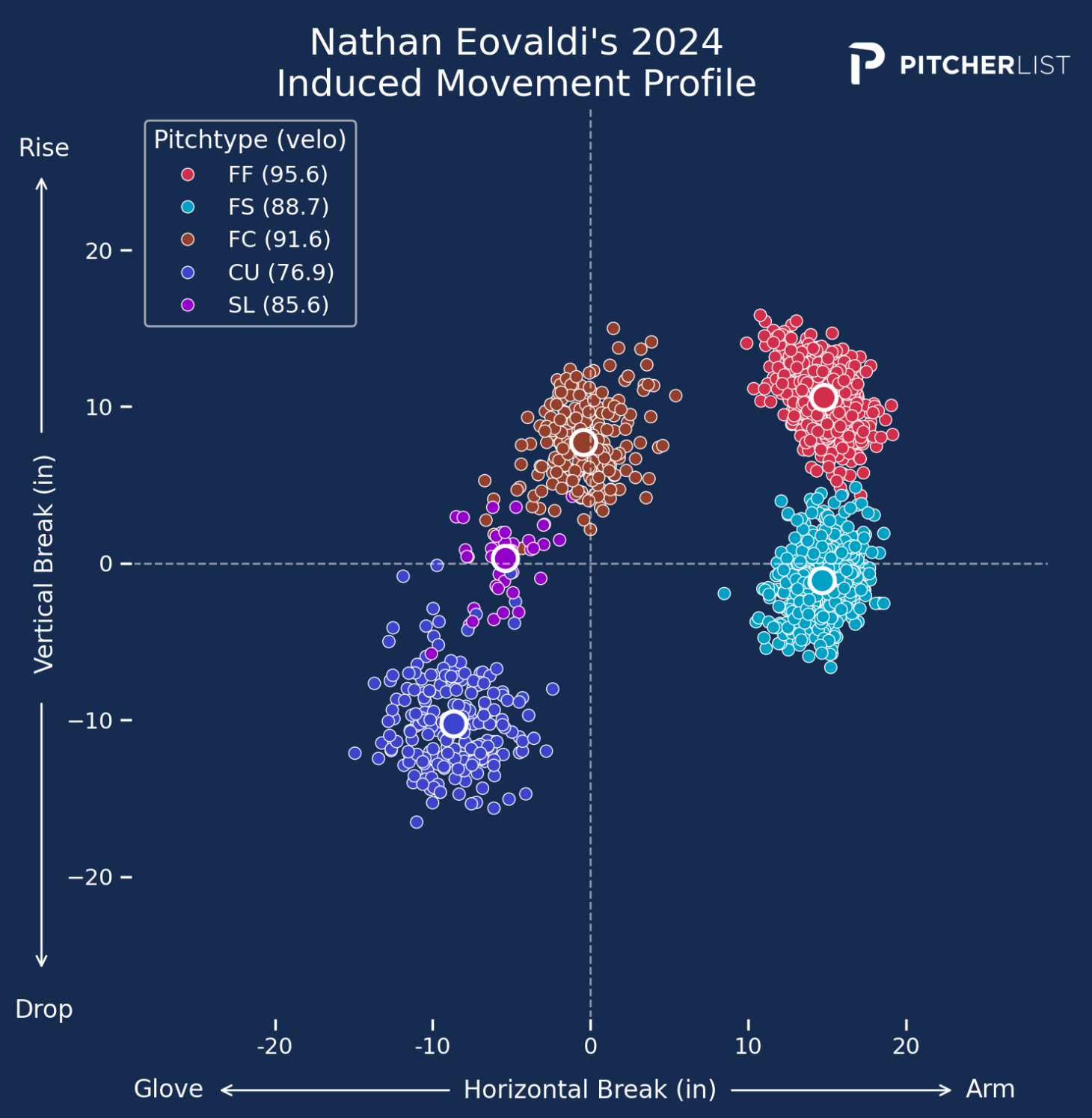
Eovaldi’s Splitter is a weapon. It comes in at 89mph, is located effectively, and cuts 10″ of IVB from his fastball. Something unique about his splitter is that he uses it early and often. His 30.3% usage rate is 88th percentile, with a 62.9% early rate (79th percentile).
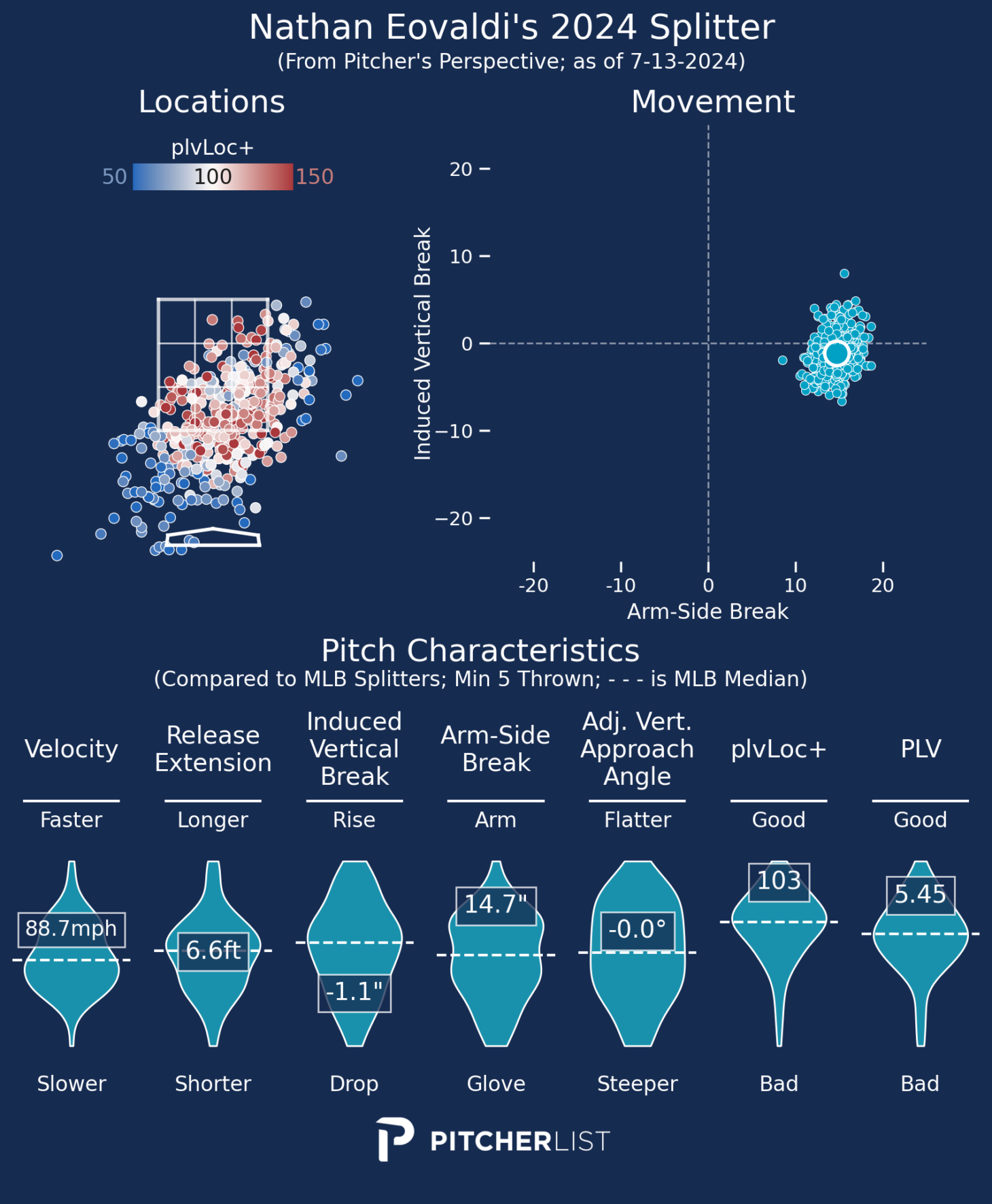
His trust in his Splitter allows him to pitch backward and fold in the four-seamer later in counts (38.6% two-stroke rate; 91st percentile), which keeps hitters off balance (.332 xwoBACON; 82nd percentile). Eovaldi may not stick with a sub-3.00 ERA, but he has clearly shown that he’s better than his results from last season (3.63 ERA, 1.14 WHIP, 22.8% strikeout rate, 8.1% walk rate).
The premier home run hitter at catcher last year, Cal Raleigh is returning to form. Not from a Power standpoint. That’s been there all season.
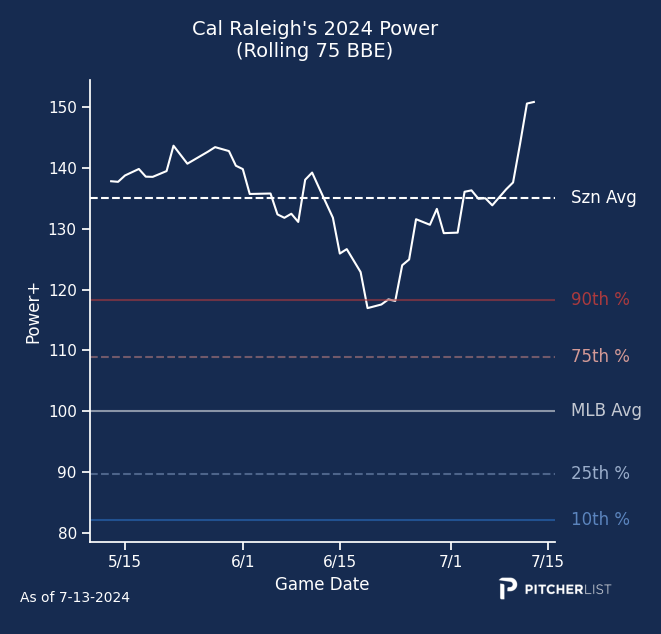
What’s been most encouraging is his improvement in his Contact Ability. It’s been a steady rise from where he started earlier in the year, and he’s finally reached league average.
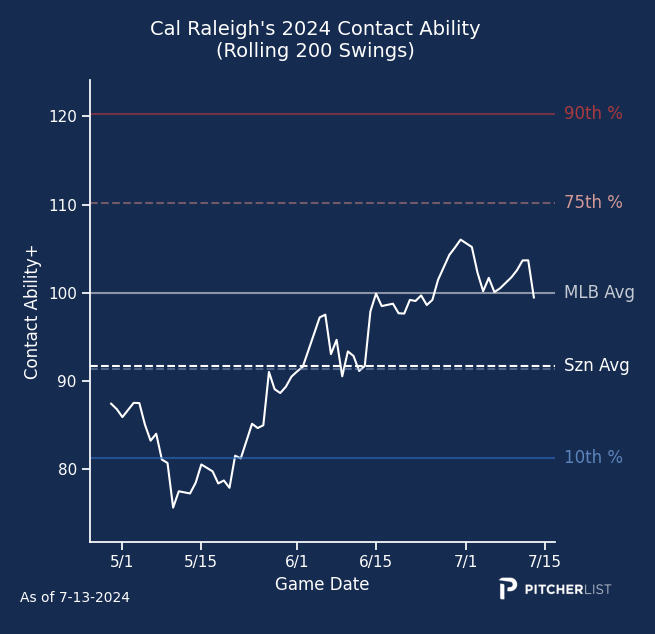
Raleigh was already due for some positive regression (.325 xwOBA vs .315 wOBA), but I think he’s primed to surpass that improvement.
NL East
This one pretty much writes itself: Zack Wheeler is the #1 pitcher in baseball right now. He’s done that by having a plethora of elite pitches that he can use at any time, against any handedness. When your worst pitch is a curveball that is still above-average at limiting hard contact (.311 xwoBACON; 63rd percentile), you’re doing pretty well at that whole “pitching” thing.
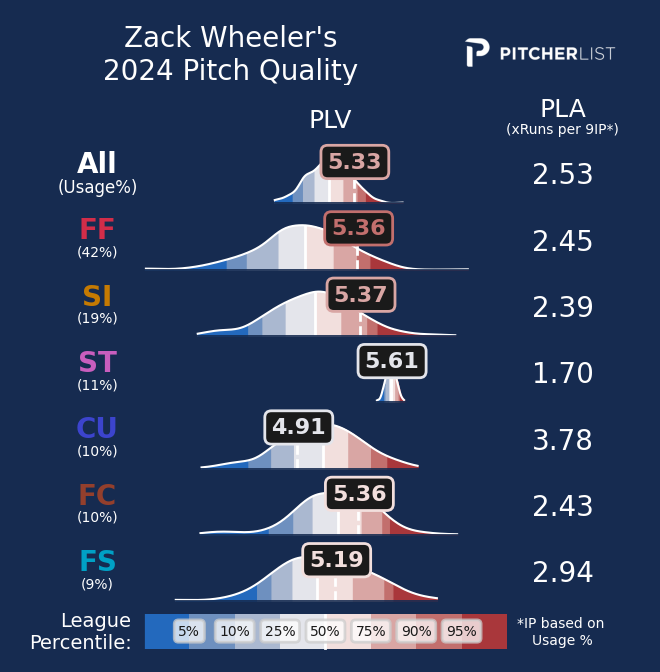
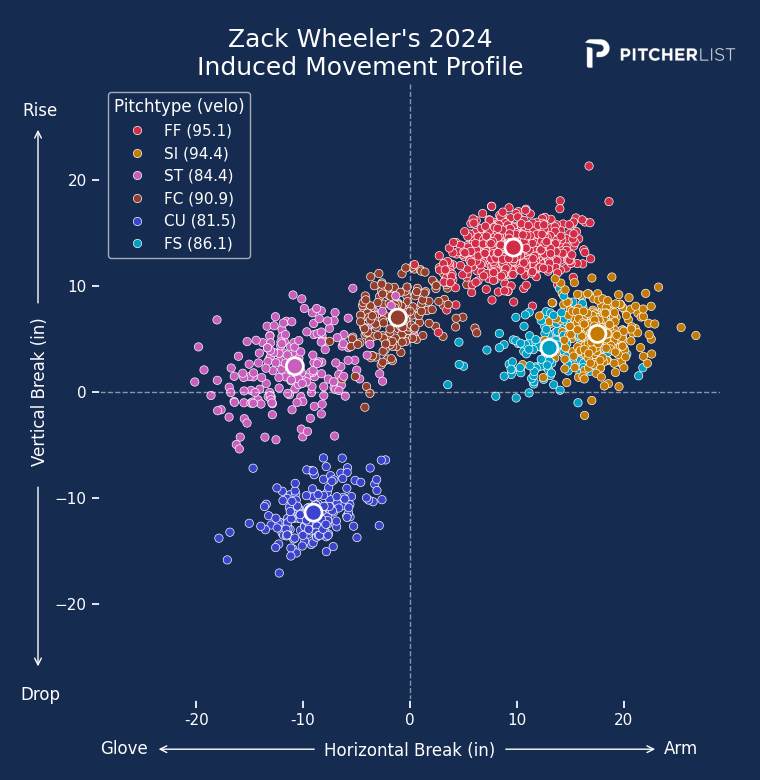
While I could highlight any of his pitches and come away impressed, I want to show that, in addition to Wheeler having six pitches he can throw, he also locates them differently depending on the handedness of the hitter. The best example is his sinker, which he pounds inside to both handednesses. If Wheeler throws a sinker, it’s coming at your hands, and that deliberate approach is one of the reasons it’s so good: it’s a very uncomfortable pitch to hit (.249 xwoBACON; 86th percentile).

And now, we have my favorite chart of the first half.
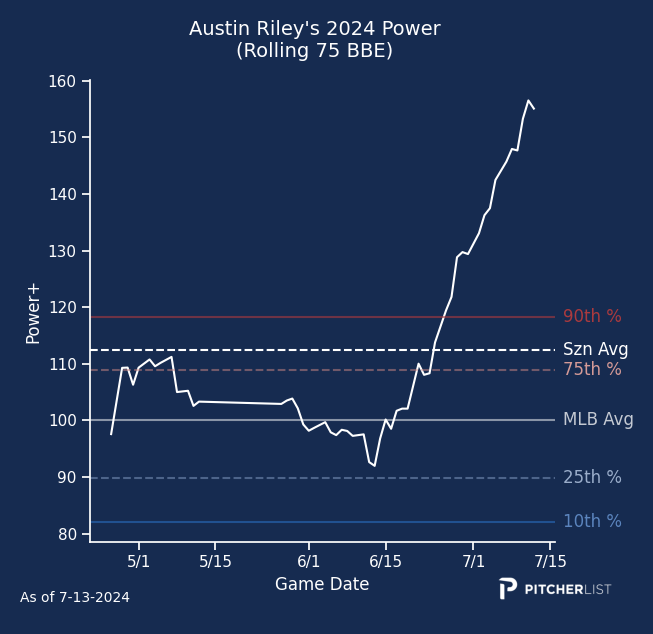
Austin Riley had been shockingly mediocre in the power department at the start of the season. A likely culprit for this woes is the oblique injury he was battling through and eventually went on the IL for (the flat line in the second half of May). Once he shook off the rust in early June, he decided that he was going to start crushing baseballs. I can’t recall seeing a chart with a rise this meteoric. He’s got to plateau/come back to Earth at some point, but I’m going to be watching every plate appearance starting the second half to see if he can maintain this incredible level of performance.
NL Central
We can’t have a list of impressive pitchers from the first half without mentioning Paul Skenes. The man has been nothing short of a revelation on the mound. He’s quickly and ruthlessly quashed any concerns about the shape of his fastball, with the pitch proving to be elite at missing bats (30.3% whiff rate and 16.5% swinging-strike rate; 95th and 98th percentile, respectively). Turns out that if you repeatedly throw a pitch at nearly 100mph, the shape of it is less important. That isn’t to say it’s the best pitch in baseball: when hitters do make contact, they hit it hard (.497 xwoBACON and 22.2% home-run-per-fly-ball rate; 11th and 14th percentile, respectively), so there’s a bit of a scary floor if a team can time up the heater.
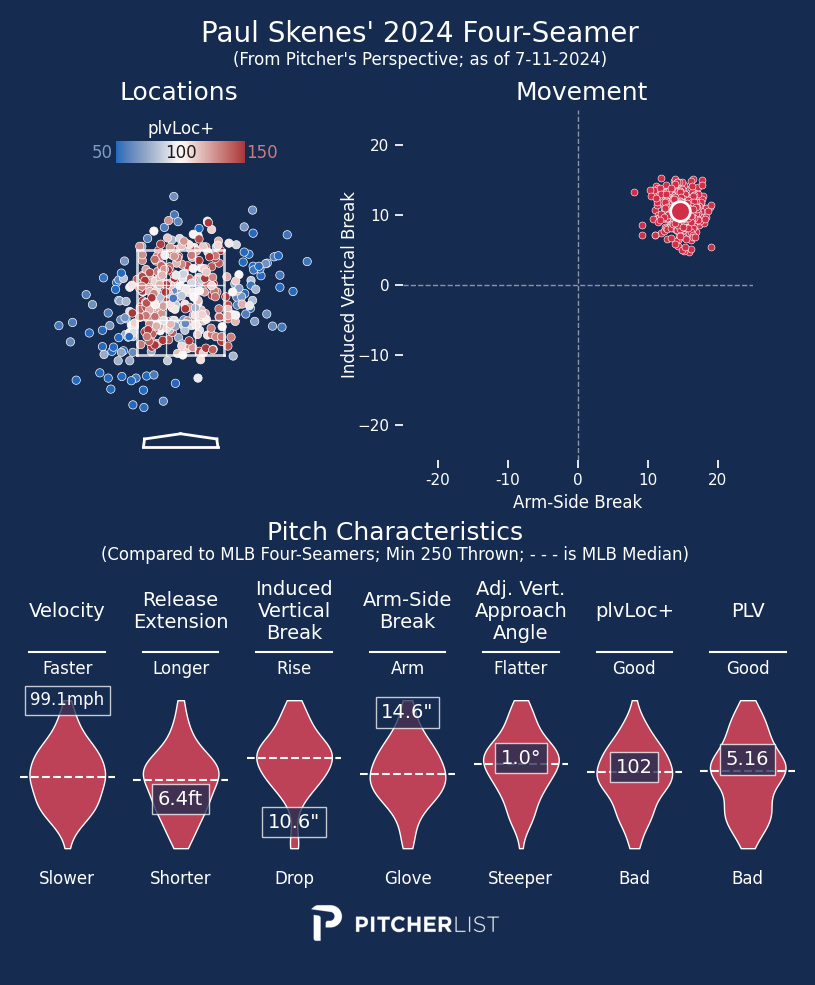
The pitch that I would argue is the best pitch in baseball is his splitter (which is also a “splinker” or “sinker”, depending on who you ask). The pitch is the ideal version of what a change-of-pace pitch should be: it’s hard but still drops five mph from his primary fastball, it cuts 11.5″ of IVB, and, most importantly, it is impeccably located. I mean, look at the way the pitch hugs the bottom and arm-side edges of the strike zone! This pitch is bananas, and it’s even crazier to consider that he picked it up after he was considered a generational prospect and was the 1st overall pick in the draft. Kudos to Skenes and whoever helped him develop and hone the pitch. It blows my mind, and I love it.
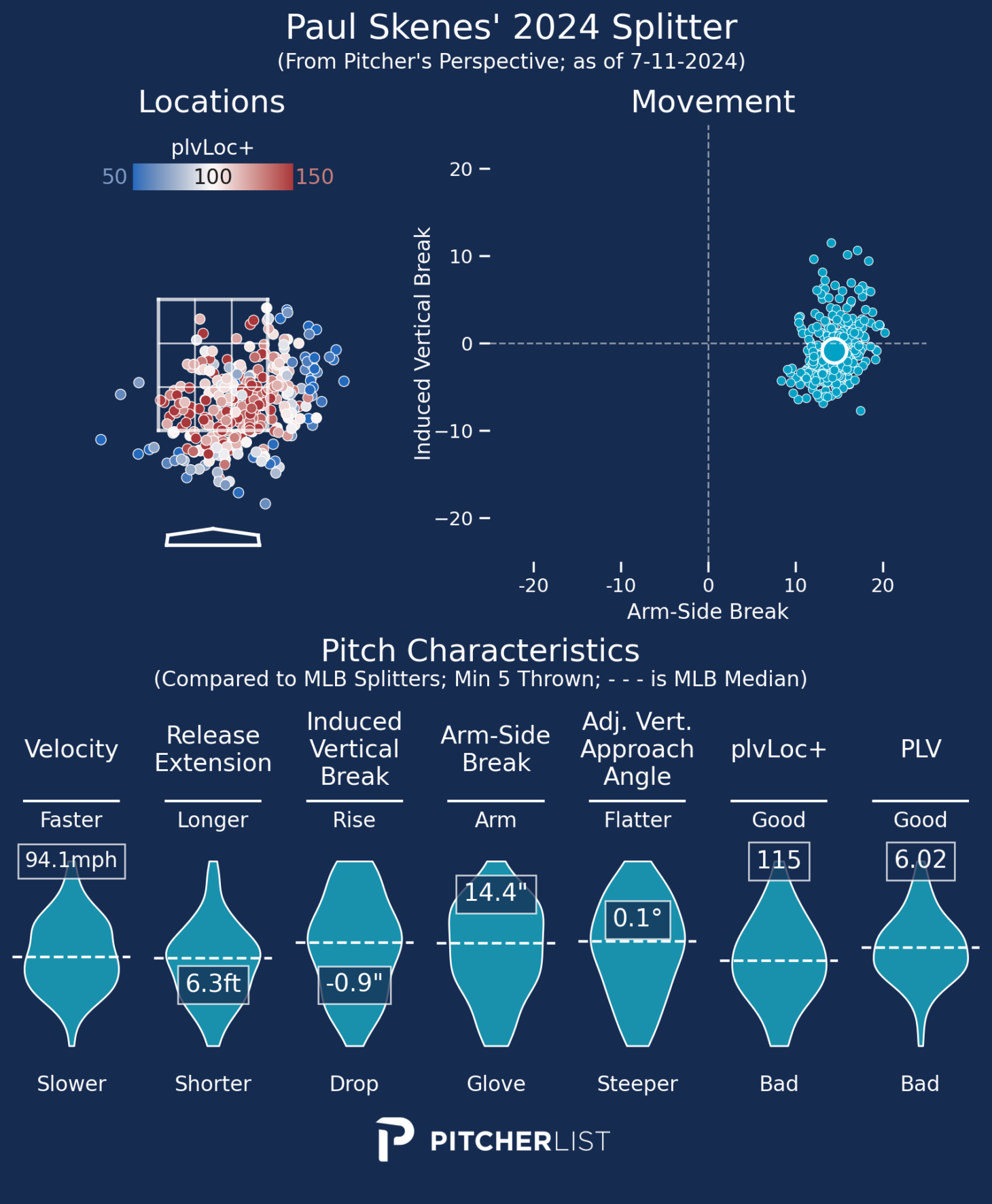
At the start of the season, Jonathan India wasn’t interested in swinging. He was simply happy to watch pitches go by, which led to a great walk rate (15.1% through May) but a terrible .316 SLG. Sometime in early June, he realized he could probably perform better if he actually swung the bat.

That’s a good thing because India has started swinging the bat better, in addition to swinging it more often. His Contact Ability+ has stayed in the 100-110 range all season, while his Power+ has started trending up. Earlier in the season, it almost seemed as if India was surprising himself when he swung the bat, but it now appears that he’s swinging with much more intent and authority, and his results bear this out (.570 SLG and 171 wRC+ since June 1st).
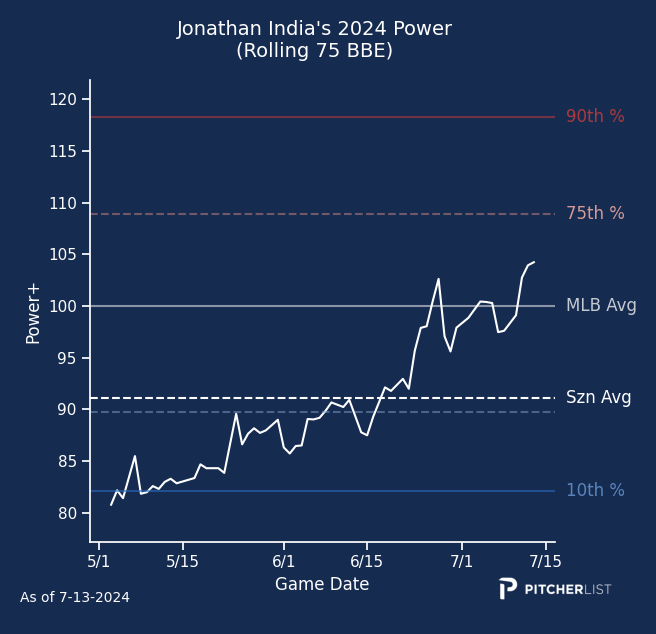
I generally think that hitters swing a bit too often (I’m not alone here), but India is the rare case where swinging more often yields much better results.
NL West
Cease’s stuff is unquestionably good (his 124 Stuff+ this year is tied for the best mark from a qualified pitcher, while his 115 Stuff+ last year was 5th). The problem for him has been his locations. Here’s his 2023 slider chart. It’s a solid pitch! A decently hard gyro Slider that is located at a roughly average level, though he tends to have big/obvious misses. A useful pitch (>5 PLV), though it’s slightly worse than the typical Slider.
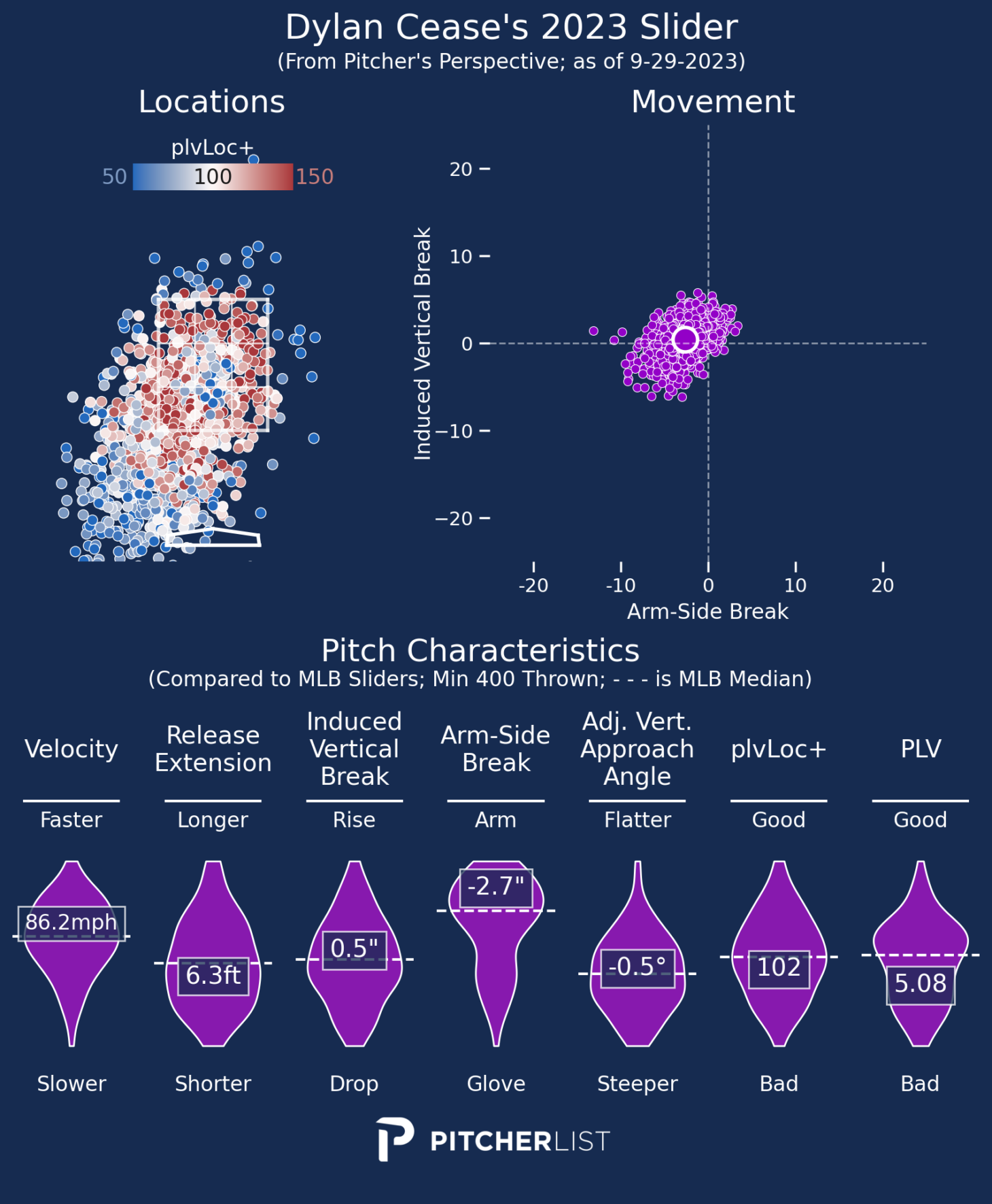
Compare that with this year’s version. It comes in one mph faster, with almost identical movement, but is now located significantly better. Look at the bottom left of the Location plot, and you can see that he’s really toned down the huge misses, resulting in a much more competitive pitch, on average.
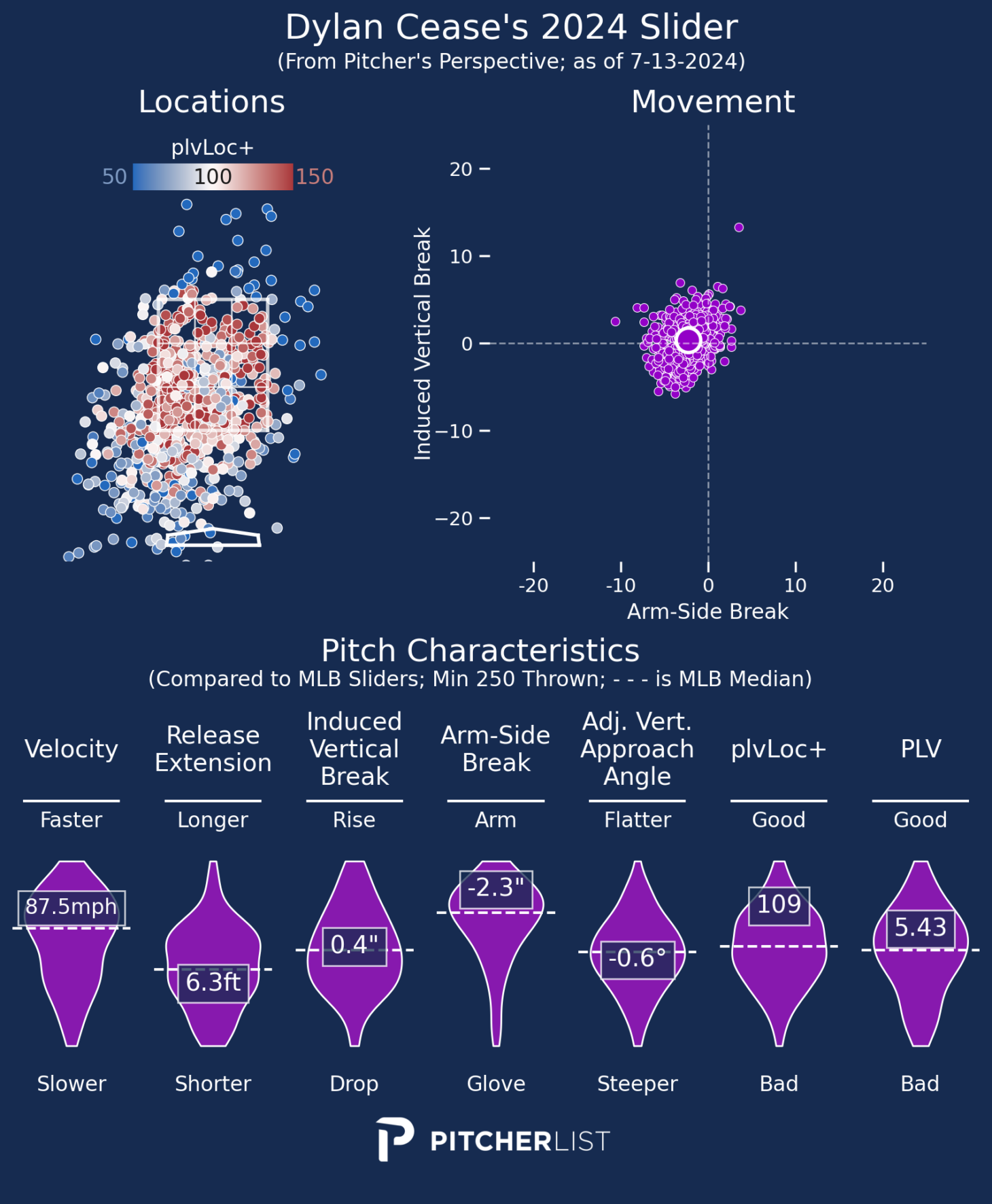
The slider isn’t the sole reason, but it is an important contributor to Cease’s increased control this season (7.7% walk rate, vs 10+% the rest of his career). Cease has finally made the change everyone has been calling for: he’s throwing more competitive pitches! He has an elevated ERA to show for it (3.99), but I believe that will come back down to what his current ERA estimators are (3.26 FIP, 3.18 xFIP, 3.42 xERA).
Brenton Doyle came into the season with a fairly interesting profile: gold-glove caliber defense at center field in the most spacious park in baseball with a DFA-caliber bat (43 wRC+.. 43!). He utilized his speed when he found himself on the basepaths (22 stolen bases), and even displayed a bit of pop that you wouldn’t expect from such an abysmal wRC+ (a somewhat Coors-inflated 14 HR/600 PA). It’s a credit to his glove that he was somehow solidly better than replacement-level last year (0.5 WAR ). The assumption this season was more of the same: elite defense with a wet noodle bat. The defense has lived up to expectations this season (he’s eighth overall by Savant’s Fielding Run Value), but the bat has vastly exceeded them. He’s gone from being literally the worst hitter in baseball (by a good margin! Tim Anderson and his one.home run in 500+ PA was next with a 60 wRC+), to being solidly above league average (112 wRC+). That’s an incredible jump, and the best part is that he’s still improving! His Contact Ability has stabilized at slightly below league-average, after hovering at that 10th percentile line all last year and at the beginning of this year. That alone is a worthwhile improvement to someone who was already a useful player.
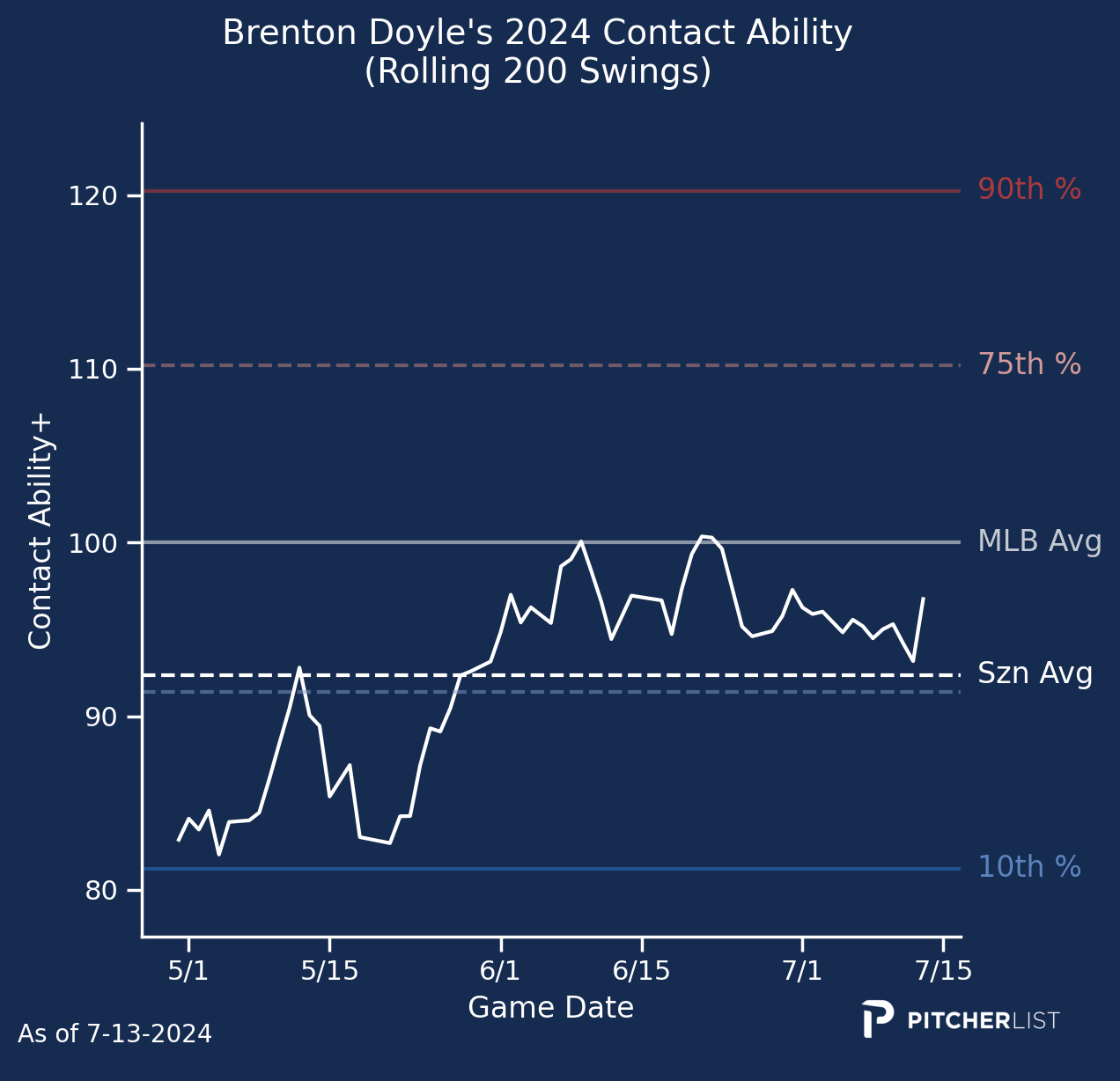
The more impressive improvement is his Power. He was roughly average last year (95 Power+) and hovered around league-average for most of this year. Recently, though, he’s taken off. He’s doing much more damage to the ball over the last few weeks, and this doesn’t even factor in the benefits he’ll see from hitting the ball harder in Coors.
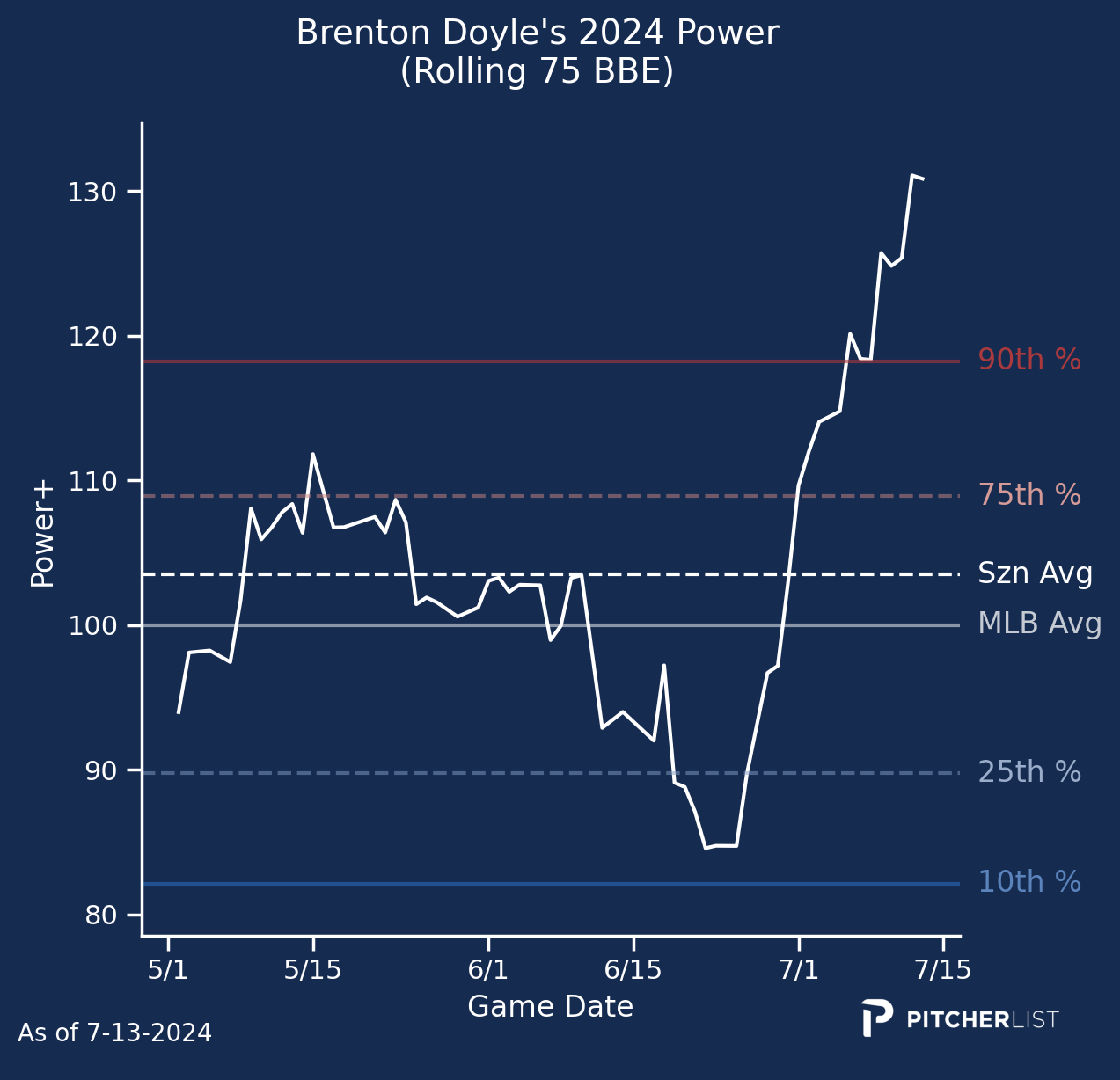
Doyle has found another level of performance, even after the improvements he made to start the year. He’s gone from defensive specialist, to valuable player, to possible down-ballot MVP vote-getter (he’s 14th in the NL in fWAR right now with 2.9, and he’s getting better). What an incredible transformation, and I can’t wait to see it continue in the second half.
Photo by Larry Placido/Icon Sportswire | Featured Image by Ethan Kaplan (@DJFreddie10 on Twitter and @EthanMKaplanImages on Instagram)

